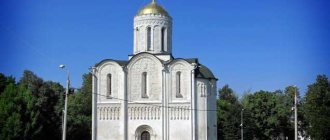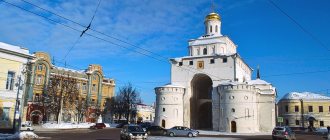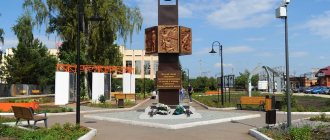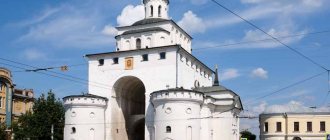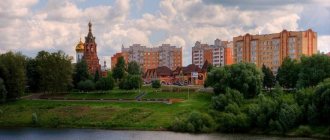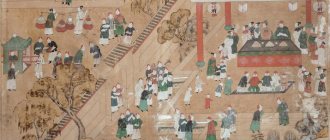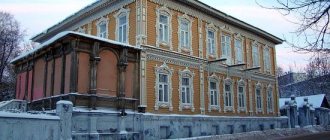Feodorovsky Monastery, Pereslavl-Zalessky
© Victor Bashkir
The Golden Ring of Russia - this beautiful phrase is the name of a group of tourist routes that are laid through ancient Russian cities, which have still preserved many unique cultural and historical monuments, and are also centers of folk crafts. This route was developed over 40 years ago, and the author of its name is the Soviet and Russian writer and art critic Yuri Bychkov, who wrote a series of essays of the same name for the newspaper “Soviet Culture” in 1967.
The main cities of the Golden Ring of Russia are the cities belonging to the Moscow, Yaroslavl, Tver, Kostroma, Ivanovo and Vladimir regions. According to generally accepted data, their list consists of eight cities: Vladimir, Suzdal, Ivanovo, Kostroma, Yaroslavl, Rostov the Great, Pereslavl-Zalessky and Sergiev Posad. However, there is other data according to which the Golden Ring includes twelve cities - the cities of Alexandrov, Yuryev-Polsky, Plyos and Uglich are added to the above. But this list can safely be called debatable.
You should also know that the composition of cities and their number may vary on each specific route. For example, a full circle trip includes more than 12 cities of the Ring, and the length of the route itself is approximately 1000 km. The classic route involves visiting the main eight cities. In most cases, routes consist of 4–7 cities, and the tourist programs themselves (calculated independently or provided by travel agencies) can last from 2–3 to 9–10 days. The most popular are tours within 5 days.
Blog "Apartments"
The first part of the trip - the Golden Ring of Russia: Sergiev Posad, Pereslavl-Zalessky, Rostov Veliky, Yaroslavl
In the cities of the Golden Ring, all stages of the development of ancient Russian architecture are represented: majestic white-stone churches of the 12-13th centuries, golden-domed churches, tent-roofed buildings of the 16th century, buildings of the 17th century, creations of architectural and painting schools of Rostov, Yaroslavl, Kostroma, Vladimir.
Kostroma. View of the Holy Trinity Ipatiev Monastery © Igor Litvyak / Photobank Lori
The Golden Ring is famous for masterpieces of folk art - the city's museums contain examples of ancient artistic crafts: wood and bone carvings, products of skilled lacemakers and jewelers, lacquer miniatures and enamel painting and much more.
If you are planning a trip around the Golden Ring of Russia, then you should spend at least two days getting to know each of the cities. It is most convenient to travel along the route by car, so as not to be tied to some excursion route that does not allow you to experience all the beauty of the Golden Ring. The tourist infrastructure is well developed in these cities - you can eat and spend the night in style and at a reasonable price. Today, in any city of the Golden Ring there are many options in the private sector: from cozy mini-hotels with homely furnishings to apartments for daily rent.
In the cities of the Golden Ring, you should definitely try the local gastronomic delights. In Yaroslavl - the most delicious donuts of the central region, in Kostroma - cheese, in Suzdal - mead and cucumbers in all forms - from fresh to pickled, in Rostov the Great - pike dishes.
Kostroma
The most distant point of the tourist ring is Kostroma - it is located 306 km from Moscow. Kostroma is a river port, the center of the Kostroma region.
On Kostroma soil, a simple peasant Ivan Susanin, at the cost of his life, saved the life of the Russian Tsar, and therefore the future of Russia. A monument to Ivan Susanin was erected in the center of Kostroma, and the ancient square began to be called Susaninskaya.
Monument to Ivan Susanin. Kostroma © Gennady Soloviev / Photobank Lori
If you look at the city plan, you will notice that the streets here are arranged in the form of a fan. There is a legend that explains this. When Empress Catherine II ordered the city to be rebuilt, she was asked what she wanted Kostroma to be like. At that moment, the empress unfolded her fan. This is how the city was made so unusual.
Shopping arcades
Church of the Savior in Rows, Kostroma © Natalya Sidorova / Photobank Lori
In the part of the city where the streets converge, there are ancient shopping arcades. The construction of shopping malls made of stone began in the center of Kostroma in 1775. Each product had its own place. The names indicate this - Large and Small flour rows, Butter rows, Gingerbread rows.
Ipatiev Monastery
The most significant of the monuments in Kostroma is the Ipatiev Monastery, founded in the 1330s.
Ipatiev Monastery. Kostroma © Natalya Volkova / Photobank Lori
“The Cradle of the House of Romanov” - in 1613, sixteen-year-old Mikhail Romanov was called to the throne here.
Epiphany-Anastasia Monastery
Panorama of the snow-white Epiphany-Anastasiin convent in the city of Kostroma, Russia. © Valery Smirnov / Photobank Lori
Epiphany-Anastasiin Monastery, founded by the disciple of Sergius of Radonezh, Elder Nikita in the middle of the 15th century. In the Epiphany Cathedral of the monastery there is the Kostroma miraculous icon of the Mother of God of Feodorovskaya - the main shrine of Kostroma and the Kostroma region.
Museums of Kostroma
Among the museums, we can highlight the Kostroma Art Museum, opened for the 300th anniversary of the House of Romanov, the Museum of Wooden Architecture,
Museum of Wooden Architecture in Kostroma - Kostromskaya Sloboda © Natalya Sidorova / Photobank Lori
Museum of Flax and Birch Bark, Snegurochka's Tower.
A girl in the role of Brownie invites people to the Snow Maiden's tower in the city of Kostroma, Golden Ring, Russia © Nikolay Vinokurov / Photobank Lori
And be sure to visit the dog monument. It is believed that touching a dog's nose brings good luck.
Ivanovo
Since the times of the Russian Empire, Ivanovo has traditionally been a center of light industry. The first textile manufactories appeared in the 17th century. Factory buildings of enterprises that have survived to this day are unique examples of Russian industrial architecture of the late 19th and early 20th centuries.
Historical district of the city of Ivanovo, summer landscape © Yakov Filimonov / Photobank Lori
Ivanovo, first of all, is famous for its monuments dating back to the era of constructivism (30s of the 20th century): this is the ship house and the horseshoe house. There are also a large number of historical and revolutionary monuments in the city, giving it a unique flavor.
Architecture of the USSR period - house ship © Yakov Filimonov / Photobank Lori
Shchudrovskaya tent
Shchudrovskaya tent. Ivanovo. XVII century © Vasily Peshnenko / Photobank Lori
The Shchudrovskaya tent is the oldest (17th century) civil brick building in the city of Ivanovo, which received its name from the merchant and industrialist Osip Shchudrov.
Several stone churches have survived in Ivanovo:
Holy Vvedensky Monastery
Church of the Holy Vedensky Monastery from above. Ivanovo. Russia © Yakov Filimonov / Photobank Lori
Funds for the construction of the monastery were collected through private donations. The foundation stone for the Vvedensky Church took place on May 21, 1901. The Holy Vvedensky Convent was opened at the temple on March 27, 1991.
Kazan Church
Temple of the Kazan Icon of the Mother of God in Ivanovo © Alexey Gusev / Photobank Lori
Burylin's mansion
This mansion was built in 1904 for the manufacturer, philanthropist and creator of the Museum of Industry and Art D.G. Burylin. Currently, the Ivanovo Calico Museum is located in the mansion, built at the beginning of the last century.
Museum of Ivanovo chintz (house of Dmitry Burylin). Ivanovo © Alexander Shchepin / Photobank Lori
There are several more must-see museums in the city - Ivanovo State Museum of History and Local Lore. D. G. Burylina, Ivanovo Regional Art Museum and the Tsvetaev Family House Museum.
Suzdal
The city of Suzdal is called a unique open-air museum. There are more than 70 monuments of religious architecture: 30 stone churches, 3 wooden churches, 5 monastery ensembles, more than 200 monuments of civil architecture. The city has preserved the traditional topography of ancient Russian cities - the Kremlin, trade and craft settlement, monasteries. Suzdal is a museum-reserve protected by the state and UNESCO.
Spring in Suzdal. Street in the city center with cherry blossoms near the houses © Yulia Babkina / Photobank Lori
Suzdal Kremlin
The oldest part of the city is the core of Suzdal - the Suzdal Kremlin. At the turn of the XI–XII centuries. a fortress was built here with a ring of earthen ramparts 1,400 m long. The Kremlin has preserved the earthen ramparts and ditches of the ancient fortress. On the territory of the Kremlin there are the Nativity Cathedral, the Assumption, St. Nicholas and the Nativity of Christ churches.
Museum "Suzdal Kremlin" in the bishop's chambers, Suzdal © Yulia Babkina / Photobank Lori
Now the Suzdal Kremlin is a museum, with numerous exhibitions dedicated to the history of the Suzdal land, famous people associated with it, treasures from monasteries and churches, ancient Russian painting and applied art. The interiors of the Cross Chamber deserve special attention. They were created from records of the 18th century and reproduce objects that surrounded its owners at that time.
Cathedral of the Nativity
The Nativity Cathedral (XII-XVI centuries) is the oldest building in Suzdal.
According to legend, it was built on the site of the Church of the Assumption of the Blessed Virgin Mary, the first Christian church in Suzdal, founded by Vladimir Monomakh at the end of the 11th century.
Cathedral of the Nativity of the Blessed Virgin Mary. Suzdal © Alexander Shchepin / Photobank Lori
This temple was huge and majestic. The six-pillar (or four-pillar) powerful building with one dome was made of thin brick and painted by the best Byzantine masters. But after about half a century, due to too weak a foundation, the cathedral began to collapse and, on the orders of Yuri Dolgoruky, was dismantled.
In 1635, opposite the southern façade of the cathedral, a bell tower was built, topped with a high octagonal tent. At the end of the 17th century, chimes were installed on it, in which the hours are indicated by letters. The cathedral, chambers and the bell tower connected to them by a passage form a closed front courtyard. One of its main attractions is the Golden Gate, a unique example of decorative and applied art by Suzdal masters. The treasures of the Nativity Cathedral were also transferred to the museum.
Pokrovsky Monastery
The Pokrovsky Convent was founded in 1364, but the current appearance of the ensemble took shape in the 16th century, when the monastery became a place of exile for disgraced queens and women of noble boyar families. In the 16th–17th centuries the monastery was one of the largest in Rus'.
Intercession Convent, Suzdal, top view © Natalya Volkova / Photobank Lori
The central monument of the ensemble is the Intercession Cathedral (1510–1518), which is distinguished by its monumentality. The building is surrounded on four sides by an open gallery; the portals of the cathedral are richly decorated. Under the building of the Intercession Cathedral there is a tomb where exiled queens, grand duchesses, noble women of the aristocratic families of Ancient Rus' are buried: Alexandra, daughter of Ivan III, Solomonia Saburova, wife of Vasily III, Evdokia Lopukhina, first wife of Peter I, Anna Vasilchikova, wife of Ivan IV, Evdokia Naked, first wife of Vladimir Staritsky, Eupraxia Pozharskaya and others.
In 1923, the monastery was closed and destroyed. In the 1950s–1960s, the monastery buildings were restored and museum exhibitions were opened in them. Since 1992, monastic life has been revived in the ancient monastery. Currently the monastery is active. He owns the cathedral, the almshouse building, and outbuildings.
Spaso-Evfimiye Monastery
Located on the picturesque banks of the Kamenka River. The monastery was founded in 1352 as a fortress to protect the city from enemies.
Spaso-Evfimievsky Monastery in Suzdal © Yulia Babkina / Photobank Lori
The main temple of the monastery - the Transfiguration Cathedral (16th century) was built in the traditions of the ancient white-stone architecture of Suzdal, it is monumental and strict. The pride of the cathedral is the 16th-century frescoes discovered by restorers on the facades, and paintings by famous 17th-century masters Guriy Nikitin and Sila Savin.
The Transfiguration Cathedral stands out for its particularly strict and canonic lines. The five-domed cathedral is complemented by two chapels in honor of St. Euthymius and St. Sergius of Radonezh. The outside is decorated with an arcature-columnar belt, characteristic of the style of that time.
By order of Catherine II, a prison was established in the monastery in 1766.
Trade area
Architectural complex of the Suzdal Kremlin © Sergey Lavrentyev / Photobank Lori
The trading area has retained its layout, scale and significance since the mid-12th century.
Handicraft workshops and shops of local merchants lined the banks of the river. There were also barns, customs and the “Gostiny Dvor of the Sovereigns with rows”. In the center of Gostiny Dvor on the spire of the front gate there is a falcon in a princely crown - the coat of arms of the city of Suzdal, established under Catherine II.
In the middle of the square, near the shopping arcades, there is the Resurrection Church with a high bell tower. It existed until the fire of 1719 and was replaced by a stone one. Nowadays, the Trade Rows contain a wide variety of stores: from jewelry to grocery stores.
Museum of Wooden Architecture
The city has the famous Museum of Wooden Architecture. It is located on the right high bank of the Kamenka River.
Museum of wooden architecture and peasant life in Suzdal. Resurrection Church from the village of Patakino, Kameshkovsky district and Transfiguration Church from the village of Kozlyatevo, Kolchuginsky district. Vladimir region, Russia © Elena Koromyslova / Photobank Lori
The museum exhibits include religious and residential buildings of the 18th-19th centuries, transported from various villages of the Vladimir land. Here there are ancient wooden churches (some are open to visitors), residential buildings of peasants of different incomes and occupations, a wheel well, outbuildings - an entire ancient Russian village.
Every second Saturday of July, the Cucumber Festival is held in Suzdal. On this day, craftsmen come together, you can see with your own eyes wood carving and painting, and the making of clay toys. You can get involved in the life of an old Russian village yourself: try minting coins, mowing the grass, try out a loom, dress in Russian folk costumes.
Vladimir
The ancient Russian city of Vladimir was founded in 990 by Prince Vladimir the Red Sun. In 1108, Prince Vladimir Monomakh fortified the city, making it a stronghold for the defense of the Rostov-Suzdal principality.
Golden Gate
In the 12th century, the Golden Gate was erected at the entrance to Vladimir, which has survived to this day. Entering the city through them is considered a lucky omen.
Russia. Gold ring. Vladimir city. Golden Gate © Litvyak Igor / Photobank Lori
Their construction lasted for 10 years. The construction of the gate was carried out using an old and proven technique: the walls consisted of a box, which was made of hewn white stone. Its interior was filled with material such as rubble, which was supported by a strong lime mortar. This masonry was called “half rubble”.
Now the Golden Gate is a museum-reserve. In the gate church there is a military-historical exhibition. The central place in the exhibition is occupied by a diorama depicting the dramatic events of February 1238: the defense of Vladimir during the assault by the troops of Batu Khan.
Assumption Cathedral
The majestic Assumption Cathedral has long been the main cathedral of Vladimir-Suzdal Rus'. The Assumption Cathedral in the Moscow Kremlin was built on his model.
Assumption Cathedral in Vladimir © Yakov Filimonov / Photobank Lori
The original white stone cathedral was built by Grand Duke Andrei Bogolyubsky in 1158–1160. Its walls were decorated with a couple of reliefs.
The paintings on the outside of the temple are peacocks, which symbolized the Resurrection, and prophets who held scrolls with texts glorifying the Mother of God.
From the original frescoes of the Assumption Cathedral, only fragments have survived to this day. The cathedral was again painted by Andrei Rublev and Daniil Cherny in 1408. From the painting, individual images of the large composition “The Last Judgment”, which occupied the entire western part of the temple, have been preserved. Most of the frescoes that have reached us were painted in the 19th century.
Next to the cathedral in 1810, a bell tower was built - a four-tiered structure with four corner pillars at the base, with arched openings (now blocked), and ending with a high gilded spire.
Dmitrievsky Cathedral
There used to be a princely court inside it. The temple has one dome, four pillars, and three apses. Initially, the temple was surrounded by galleries with staircase towers, connecting it with the princely one.
Dmitrievsky Cathedral. Vladimir © Natalya Volkova / Photobank Lori
First of all, the cathedral is famous for its white stone carvings - its walls are decorated with about 600 reliefs with images of saints, mythical and real animals. Most of the reliefs have been preserved in their original form, some were replaced during the restoration of the 19th century.
On the northern façade, facing the city, you can see a bas-relief with the image of Prince Vsevolod the Big Nest. He is depicted as a man seated on a throne, at whose feet four people fall. The prince is holding a child on his knees, this, as you can easily guess, is his son Vladimir.
The southern façade of the cathedral faces the Klyazma River and on it we see the bas-relief “The Ascension of Alexander the Great”. It is believed that the plot for the image was taken from a medieval Russian story about Alexandria. Vladimir craftsmen also borrowed the Greek legend of Hercules, which is depicted on the western wall.
From the interior decoration, several fragments of frescoes from the 12th century have reached us, such as “The Last Judgment”, “Paradise”, “Procession of the Righteous to Paradise”. Among all the icons of the temple, the most expensive and famous is rightfully considered the icon with the image of Dmitry of Thessaloniki, which was brought to the Demetrius Cathedral from Thessalonica.
Currently, the cathedral is open as a museum exhibition. The Assumption and Demetrius Cathedrals are among the UNESCO World Heritage Sites.
Church of the Intercession on the Nerl
One of the most beautiful and most famous churches in the city of Vladimir and all of Rus' is the Church of the Intercession of the Blessed Virgin Mary located on the banks of the Nerl River, or, as is commonly called, the “Church of the Intercession on the Nerl”.
Church of the Intercession on the Nerl. Bogolyubovo. Russia © Sergey Lavrentyev / Photobank Lori
The Church of the Intercession on the Nerl was built by Andrei Bogolyubsky in memory of his beloved son Izyaslav, who died during the campaign of the Vladimir army against Volga Bulgaria. The white stone for facing the temple was, according to rumors, brought from there - as an indemnity.
The father wanted to get at least some consolation in the death of his son, and his fatherly love resulted in the construction of the first temple in Rus' in honor of the Intercession. The temple is considered one of the greatest masterpieces of Russian architecture; it is structurally very simple - an ordinary cross-domed temple.
It is distinguished from other Vladimir churches by its amazing lightness. The proportions of the temple are considered very elegant, and the composition is simple, which, in comparison with the majesty and wealth of the Assumption Cathedral, was supposed to symbolize the victory of spirit over matter.
The outside walls of the facades are decorated with white stone carvings, traditional for Vladimir cathedrals. On all three walls the same scene is repeated - King David sitting on a throne and surrounded by doves and lions.
In total, there are 239 state-protected buildings from the 18th–19th centuries in Vladimir. Be sure to visit the Nativity Monastery, which served as the seat of the head of the Russian church, where the chronicle was kept and the oldest handwritten copy of the Laurentian Chronicle was kept, the Trading Rows, Cathedral Square, the Nativity Monastery, Kozlov Val and the water tower, at its top there is an observation deck, a monument to the 850th anniversary of Vladimir - pyramids with three heroes, “Old Vladimir” museum.
Traveling along the “Golden Ring” of Russia is suitable for any time of year. It’s amazing how different the cities of the Golden Ring are in terms of atmosphere and recreational opportunities. This is a unique opportunity for those who are interested in the history and culture of Russia to get to know its ancient capital and other cities on which the past centuries have left their mark.
List of cities in the Golden Ring of Russia
There is no strictly defined list of cities in the Golden Ring. Usually there are two route options, differing in the number of participating cities. The classic route includes eight settlements in five regions:
- Vladimir and Suzdal (Vladimir region);
- Yaroslavl, Rostov and Pereslavl-Zalessky (Yaroslavl region);
- Kostroma;
- Sergiev Posad (Moscow region);
- Ivanovo.
In the second route option, Ivanovo is excluded from the list and the following are added:
- Ples (Ivanovo region);
- Tutaev and Uglich (Yaroslavl region);
- Yuriev-Polsky and Alexandrov (Vladimir region).
Recently, Kasimov (Ryazan region) and Kaluga were included in the route. Thus, the number of settlements on the route can vary from 8 to 14-15.
Many other cities in Central Russia, such as Myshkin, Murom, Gorokhovets, Shuya, etc., also apply for inclusion in the route list, since their tourism potential is not inferior to the cities that are part of the Golden Ring. However, there has not yet been an official expansion of the list of cities participating in the route to include these settlements.
Kostroma
Founded by Prince Yuri Dolgoruky in 1152 as a border settlement. Gradually the city turned into one of the largest Volga ports and is one of the oldest Russian cities. But many cultural monuments, especially temples and religious buildings, were badly damaged or completely destroyed during the Soviet era.
Significant architectural monuments include:
- Ipatievsky male and female Epiphany-Anastasia monasteries;
- Restored Kostroma Kremlin;
- Churches of the Resurrection on Debra, St. John Chrysostom, Nativity of Christ on Gorodishche, Transfiguration beyond the Volga.
- The Kostromskaya Sloboda Nature Reserve, which is a museum of wooden architecture.
Holy Dormition Princess Convent
Address: Knyaginin Monastery, building 37
The name of the monastery goes back to the wife of Prince Vsevolod the Big Nest, Princess Maria. It was in her honor that the monastery was erected. After a serious illness, Mary, taking the Orthodox name Martha, dedicated herself to God within the walls of the monastery.
The building, built in the 13th century, is a tomb for noble women of the princely family. Its walls contain relics and miraculous icons, including the image of the Bogolyubskaya Mother of God. The monastery managed to survive a series of turmoil and is now open to pilgrims.
Suzdal
Suzdal was founded around 982 by the Kyiv prince Vladimir Svyatoslavovich. Already in 1157 the city became the center of the Rostov-Suzdal, and then the Suzdal principality.
The city has well-preserved monuments of ancient Russian and later architecture:
- Suzdal Kremlin, dating from the end of the 10th century;
- Mother of God Nativity Cathedral (1222-1225), rebuilt in the 16th century;
- Bishops' chambers of the XV-XVII centuries;
- St. Nicholas and Nativity churches of the 18th century;
- Alexander, Pokrovsky, Vasilyevsky, Robozhensky and Spaso-Efimevsky monasteries;
- The ensemble of Trade Square with numerous churches: Sorrowful, Resurrection, Pyatnitskaya, Entrance to Jerusalem, Kazan, Tsarekonstantinovskaya churches.
Ivanovo
It is the “youngest” among the cities of the Golden Ring and was founded approximately at the end of the 14th – beginning of the 15th century. For a long time, Ivanovo was a small settlement belonging to the ancient family of the Shuiskys, then the Cherkasskys and the Sheremetevs. But with the development of textile production in the first half of the 18th century, rapid growth of the settlement began and it turned into a city.
Is it difficult to figure it out on your own?
Try asking your teachers for help
Solving problems Tests Essays
There are relatively few ancient architectural monuments of the Old Russian period in the city: the wooden Assumption Church and the Shchudrovskaya Tent. The stone church in the name of the Kazan Icon of the Mother of God, the Vladimir and Ilyinskaya churches, the Vvedensky Church were built in the period from the late 18th to early 20th centuries, like many mansions of city manufacturers and merchants. Also interesting are the monuments of avant-garde architecture of the 1920-1930s: the railway station, the Horseshoe House and the Ship House, factory-kitchen No. 1, the IVPI complex, the factory buildings of “Red Talka”.
Rostov Veliky
One of the oldest Russian cities (founded according to various sources in the 9th-10th centuries), which was one of the centers of the Vladimir Principality, and from the beginning of the 13th century - the capital of the Rostov Principality. For a long time, Rostov was a lively city of the Russian kingdom, so today it has countless architectural monuments from the 11th to the 20th centuries: monasteries and churches (the most famous are the Avraamiev Epiphany Monastery of the 11th century and the Spaso-Yakovlevsky Monastery), the Rostov Kremlin Museum-Reserve (one of the few Kremlins that have survived to this day in its original form), more than two dozen museums.
Yaroslavl
Named in honor of Prince Yaroslav the Wise, who founded the city in 995. Initially it was a small border settlement, but since 1218 it has become the center of the Yaroslavl principality and the largest city on the Volga. Until 1918, the city was actively developing and building up, and many called it “Russian Florence.”
Therefore, the city can boast of architectural and cultural monuments of different eras, museums, churches and monasteries:
- The historic city center is included in the UNESCO World Heritage List. During the reign of Catherine II, large-scale urban construction was launched here, many buildings are monuments of Russian classicism: Ilyinskaya (modern Sovetskaya) Square, Spiritual Consistory, Nekrasov's gazebo, Demidov Pillar, Bolkonsky's house and the Matveev estate;
- Holy Transfiguration Monastery and the Cathedral of the Transfiguration (1505-1515), Tolgsky Monastery - monuments of the era of Ivan the Terrible;
- Numerous churches and temples of the “Golden Age” (pre-Petrine era), richly decorated with paintings and frescoes and distinguished by syntheses of Russian and Eastern architectural traditions: Assumption and Resurrection Cathedrals, churches of the Nativity of John the Baptist, John Chrysostom, Barbara the Great Martyr, Elijah the Prophet, Savior on the City, Vladimirskaya and many others.
- Temples in the style of Russian patterns: churches of the Epiphany, Annunciation, Nativity of the Virgin, churches of Nikitsky and Annunciation parishes;
- The Vakhrameev House in the Elizabethan Baroque style and the hospital church of the Tolginsky Monastery in the Moscow Baroque style.
Pereslavl-Zalessky
Founded in 1152, Pereslavl-Zalessky was supposed to become the capital of North-Eastern Rus', but after the death of Yuri Dolgoruky it lost its capital importance, although it remained one of the largest cities in the region, comparable to Kiev and Smolensk.
The city is rich in numerous cultural and architectural monuments. It contains six Orthodox monasteries, four of which are active: Nikitsky, Nikolsky, Fedorovsky and Holy Trinity Danilov. Two more monasteries: Sretensky Novodevichy and Goritsky were closed around the middle of the 18th century and are now architectural and museum complexes.
Did not you find what you were looking for?
Just write and we will help
Also in the city is the Transfiguration Cathedral, built in 1152. It is the same age as the city and the oldest cathedral in North-Eastern Rus'. The monuments of temple architecture include the Vladimir Cathedral of the first half of the 18th century, the Simeon Church and the tented church of Peter the Metropolitan, erected at the end of the 16th century, the Vladimir Cathedral (1740), the Church of the Forty Martyrs (1755), the Intercession Church (1798). All that remains of the Pereslavl Kremlin are the ramparts of the 12th century and several church buildings that were previously located on its territory.
Sergiev Posad
The first on the route is the legendary city of Sergiev Posad, which is famous for its Trinity-Sergius Lavra. This Lavra was founded by one of the most famous Russian ascetics, Saint Sergius of Radonezh in 1337. Today, the Trinity-Sergius Lavra is the largest monastery of the Russian Orthodox Church. In addition to the Trinity Monastery, built in the 14th century, the ensemble of the Lavra also includes later buildings of the 16th-20th centuries: the Assumption Cathedral and the Spiritual Church, the Nadkladeznaya Chapel, the Church of the Nativity of John the Baptist, the Cellar and Fortress Chambers, the royal chambers, the Refectory, the Smolenskaya and Mikheevskaya Church, Metropolitan's chambers, bell tower and many others.
In addition to the Trinity-Sergius Lavra, the architectural monuments of Sergiev Posad also include the Gethsemane Chernigov Skete, assigned to the monastery, the restored Spaso-Bethans Monastery, the Sergiev Posad State Historical and Art Museum-Reserve, as well as the Bartram Toy Museum, founded in 1918. Not far from the city there is the Abramtsevo estate-reserve, famous for the fact that famous writers often visited here and the so-called Abramtsevo art circle was formed.
